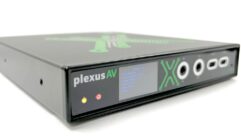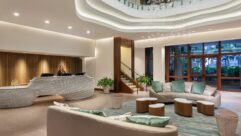
Array, or not to array? That is the question
Mar 14, 2012 2:49 PM,
By Bob McCarthy
Speaker considerations for best deployment.

Figure 1: Response comparisons of a single speaker and array pairs in the 4kHz range. (a) Single speaker with 80° coverage (b) 2×40° speaker splayed at 40° combine to 80° (c) 2×40° splayed at 20° (50% overlap) combine to 40° (d) 2×40° speakers at 0° combine to less than 30°. As overlap increases the coverage narrows. See larger image.
Let’s begin with a hypothetical question: Is a single loudspeaker better than an array of loudspeakers? If we can level the playing field by making the single speaker an exact match in power capability and coverage pattern, the decision is clearly in favor of the solo speaker. All other things being equal, we are far better off with a single source of sound instead of the complications and irregularities arising from multiple arrivals from a speaker array. Wouldn’t the ultimate speaker be a single device with enough power and coverage to fill a stadium? It doesn’t seem so.
Everywhere we turn, whether in stadiums or small theaters, we see more and more arrays of smaller speakers and fewer examples of large-format solo speakers. Are we chasing a fad or are there sound reasons behind these trend lines?
This two-part article will address the seemingly simple question: to array or not to array? The answer requires a few steps. First, we must establish the nature of the response of a single speaker. The behavior of an array is the sum of the parts, so we cannot possibly understand the grouped behavior of speakers without first knowing the individuals. As we learn about the single speaker we will find its natural limitations. Finally, we will see how the array behavior opens important new possibilities that a single speaker cannot practically achieve.
THE SINGLES PROFILE
Hi. I’m an 80-degree-by-40-degree active two-way speaker with a front-loaded 15in. woofer and 4in. diaphragm compression driver on a constant directivity horn. I have a working range from 50Hz to 18kHz and can make peak SPL’s in the 136dB range. I love Steely Dan and quiet walks on the beach. This is a typical solo speaker that might also find itself in small arrays. Exactly what is this character and what would it take to duplicate it with an array? First, let’s look at the peak SPL, a single number that integrates the maximum combined level over the entire frequency range. We can get 136dB SPL from two speakers that each produce 130dB, three that produce 127dB, or four that can generate 124dB each. Simple 20 log math. Next, we can look at duplicating the coverage pattern. We can match the 80-degree plane with two 40-degree elements, four 20-degree cells, or eight 10-degree units. We can even go nuts and do 80 1-degree elements.
Array, or not to array? That is the question
Mar 14, 2012 2:49 PM,
By Bob McCarthy
Speaker considerations for best deployment.

Figure 2: Response comparisons of a single speaker and array pairs in the 500Hz range. (a) Single speaker with 160° coverage (b) 2×160° speaker splayed at 40° combine to 65° (c) 2×160° splayed at 20° (88% overlap) combine to 65° (d) 2×160° speakers at 0° combine to 70°. Overlap is so high in all cases that the differences in splay angle don’t matter. See larger image.
Let’s dig a little deeper. The first reveal is that SPL numbers are as easily manipulated as political polling data. Typical SPL numbers (weighted or not) reduce the entire frequency range to a single value. If we have a 136dB SPL peak spec on our cabinet that does not mean we get 136dB SPL at all frequencies (or for that matter, any single frequency). It is an aggregate total over the entire range. Individual frequencies are unlikely to make it within 20dB of that number before breaking into hard distortion, or worse. The SPL capability distribution over frequency will vary tremendously, with the LF range of any given driver in the system typically falling furthest behind the pack. When we put multiple drivers together in an array, the SPL capability over frequency is substantively revised due to the shared effort of the speakers. The full range SPL number will likely miss the difference in LF power capability of eight 10in. drivers over a single 15in. driver. Maximum SPL is easily the most overrated statistic in audio.
Now, let’s dig a little deeper into coverage pattern. So we have an 80-degree speaker, eh? Is it 80-degree over the speaker’s full operating range of 50Hz to 18kHz? OK, so we know to give 50Hz a pass, but exactly (or even approximately) how wide is the range that we can expect our 80-degree spec to hold true? If you were thinking 1kHz, you would be wrong because there is no standard. The specified value is whatever folks want to print, and it can vary from covering multiple octaves to as small as one-third octave.
Let’s back up a moment and consider what we know about coverage patterns. First, we know that the pattern will widen as frequency falls. It would be fair game to specify nearly every full-range speaker in the world as a 360-degree device (if we used 50Hz as the standard). We also know that a front-loaded cone driver will become more directional as frequency rises—a property known as “proportional directivity.” This makes specifying these drivers a slippery prospect. Third, we know that horns can create a coverage pattern that is a stable frequency even for multiple octaves. Bigger horns can handle lower frequencies and, therefore, extend the controlled range downward. Horn size and depth also play a role in the pattern width. As a general trend, a bigger, deeper horn can create a tighter pattern.

Figure 3: The coverage angle over frequency for eight different versions of 80° coverage. All configurations have 80° coverage in the HF range. As quantity rises the midrange and low-frequency range move downward toward 80° (and even beyond). Note that the three-box configuration uses a large format horn-loaded woofer. Therefore it has a much more directional LF section to begin with. See larger image.
To put this all in perspective: Our little 80-degree frontfill with a 1in. tweeter and tiny horn might actually hold that pattern from 4kHz to 8kHz. By contrast, our example speaker (with a 4in. compression driver and horn) should be able to hold that spec from 1kHz on up. Below 1kHz, it will transition into the LF driver, which is likely to be fairly close to 80 degrees there and then get gradually wider as frequency falls.
Now let’s consider the 40-degree side of our example box. The horn is the same size and depth, but it has a different wall shape to get the narrower pattern. This will work fine enough, but something has to give. The pattern will probably not hold all the way down to the 1kHz frequency range like it did in the 80-degree plane. Therefore, we can think of the following trend lines in coverage pattern specifications: Wide coverage over a wide range can come in any size, but will hold its spec over a wider range as box size increases.
Large boxes with narrow coverage can hold their spec for a large range. Small boxes with narrow coverage only hold their spec for a small range. The smaller the box or the smaller the angle, the smaller the controlled range. That little 5-degree box you are about to fly is unlikely to hold its spec for more than a few notes around 8kHz.
Now we know a few things about a single box. From this we will build the case for how arrays work. But first we will take a brief moment to consider the room and the shape of our target: the audience seating line. Where do I want the sound to land so that it falls on the people? This is the most important consideration in choosing a solo speaker or an array. In the horizontal plane, we need to spread the sound from side to side like butter on bread. In the vertical plane, we need to drop a single line of sound from the front to the back. In either case, these target shapes are the same for all frequencies. We won’t find rooms that are narrow in the HF range and wide in the lows. Therefore, what we need is a speaker system that can maintain its shape over frequency. For solo speakers, this leaves us with two main options: a wide speaker (various sizes) or a large-sized narrow speaker. If we combine speakers into arrays, we can get any shape we want. It just costs money. I could use arrays. We all need arrays, right?
Array, or not to array? That is the question
Mar 14, 2012 2:49 PM,
By Bob McCarthy
Speaker considerations for best deployment.

Figure 4: Response comparisons of a single speaker and four, 16, and 40 element arrays in the 4kHz range. From left to right: (a) Single speaker with 80° coverage (b) 4×20° speaker splayed at 20° (c) 16×10° splayed at 5° (d) 40×10° speakers at 2°. Coverage is always 80° but becomes sharper at the edges a quantity of elements increases. See larger image.
STANDARD ARRAY CONFIGURATIONS
Arrays are the sum of their parts. There is plenty of buzz out there that could make one believe that arrays (especially line arrays) are an organism of their own with behavior that is only tangentially related to the original elements. Measuring a single element and then measuring it again in an array easily disproves this. The array behavior is multiplication and division of the original element response. More on this as we go.
First, let’s define exactly what an array is. An array is a configuration of two or more elements. A solo speaker that has “line array” printed on its grille is not an array, but a pair of cellphone speakers playing the same ring tone are. An array configuration is a relationship between elements. In practice, there are six basic array configurations, subdivided by two independent factors: angular orientation and displacement between elements. The relative angle can be outward (point source), inward (point destination), or parallel (line source). If the displacement is small, we have a coupled array that combines for power, such as a subwoofer and main arrays. If the displacement is large, we have an uncoupled array that combines for range extension, such as the spread elements of a frontfill array or a parade route. Each of the geometric planes is evaluated separately, so we could look at a close grouping of four boxes in a two-over-two configuration as a coupled point source in both planes. A straight line of frontfills, by contrast, would be an uncoupled line source in plane and a single element (not an array) in section.
When two elements of an array combine, one of three things happens: The coverage gets wider (multiplication), narrower (division), or breaks even. The decisive factor is the ratio of isolation versus overlap. If isolation between the elements is high (overlap is low), the sound spreads out. If isolation is low (overlap is high), the sound concentrates in the overlap region and the pattern narrows. If the two factors are equal, there is a stalemate and the pattern stays the same. The maximum overlap can cut the pattern in half and add up to 6dB of SPL. Maximum isolation can double the pattern width but won’t add level. In the land between these extremes, we find smaller changes in pattern shape and SPL addition.
Array, or not to array? That is the question
Mar 14, 2012 2:49 PM,
By Bob McCarthy
Speaker considerations for best deployment.

Figure 5: Response comparisons of a single speaker and four, 16, and 40 element arrays in the 63Hz range. (a) Single speaker with 360° coverage (b) 4×20° speaker splayed at 10° creates 200° coverage (c) 16×10° splayed at 5° creates 90° coverage (d) 40×10° speakers at 2° creates 52° coverage. See larger image.
COMPARING SINGLES, COUPLES, AND BEYOND
The workhorse of the modern sound system is the coupled point source. The most common modern version consists of a curved line of boxes acting as a single element in the horizontal plane and a coupled point source in the vertical plane. Let’s compare and contrast a single 80-degree speaker with an 80-degree coupled point source. We will create our 80-degree point source seven different ways, varying from two units splayed 40 degrees apart, up 40 units splayed 2 degrees apart. Each of these configurations will meet the 80-degree spec, but they will differ in how much of their operating range holds that number. Notice the simple math behind the example arrays here: Multiply the number of elements by the splay angle and you will get 80 degrees every time. Is it really this simple? Not quite. Is it just coincidence? Not at all.
Let’s start with the easiest one: a pair of 40-degree speakers splayed 40 degrees apart will add up to 80 degrees. This is the 100-percent isolation scenario, with the isolation being achieved by splay angle with each speaker taking on half of the job. How is this different from a single speaker? The principal differences in coverage shape are two-fold: an area of comb-filter interaction around the center and sharper edges on the outside of the pattern. Otherwise the patterns match. Figure 1 shows a comparison of the single 80-degree speaker and three array configurations of 40-degree elements (40 degrees, 20 degrees, and 0 degrees respectively). The plots show the 100-percent isolated array (40-degree splay) duplicates the single coverage, where the 50-percent and 0-percent isolated version cause pattern narrowing.
By contrast, the individual patterns are very wide in the low end. Therefore, even the widest splay angle (40 degrees) leaves the speakers highly overlapped. Therefore, the two-box array is consistently narrower than its single counterpart. This is shown in Figure 2 where the individual 500Hz response (160 degrees) is compared to the two-box version (65 degrees).
Now let’s move on by filling up our 80-degree slice of coverage with three, four, eight, 16, and finally, 40 speakers. Each added speaker brings a new set of relationships to all the other speakers. The isolation/overlap equation plays out in every pairing of boxes. In the case of the 40-box array that is around 780 pairings! Now recall that the individual elements change their response over frequency and you get a feel for just how complex this all is. Fortunately, even though the math is super complex, the observable (and predictable) behavior is straightforward.
As we slice the pizza into smaller and smaller pieces, we wisely choose narrower individual elements. The two-element configuration must have at least a 40-degree element, and for each doubling of quantity we can cut the minimum coverage in half. Recall that individual speakers can’t hold 5-degree patterns beyond a small range of high frequencies. Therefore, isolation percentage rises with frequency and overlap percentage increases as we move down the spectrum. That is how we can start with an element that is 360 degrees wide at the low end and 5 degrees wide at the top end and build an array that ends up around 80 degrees at both ends. Isolation spreads the top, while overlap squeezes the bottom. The extended quantity creates a push-pull between these factors that keeps the coverage angle consistent over frequency.
Figure 3 shows a chart of coverage angle over frequency of our eight versions of 80 degrees. Notice that as quantity increases we are able to extend the control of the array all the way down. In fact, the 40-box scenario is so long that it is actually narrower than 80 degrees. Yes, we can have too much of a good thing! Figures 4 and 5 have some plots of the array responses. A complete set of the data is available on my blog: bobmccarthy.wordpress.com
So now we know how we can get an array to mimic a single speaker and even to be able to create an idealized speaker response with uniform shape over frequency. In part two, we will explore how to use arrays to bend the shape of sound to get optimal coverage over the space.










